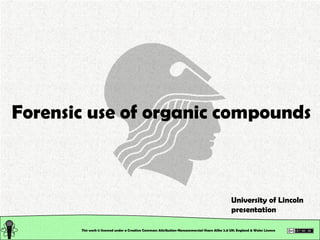
Organic Chemistry: Forensic use of organic compounds
- 1. This work is licensed under a Creative Commons Attribution-Noncommercial-Share Alike 2.0 UK: England & Wales License Forensic use of organic compounds University of Lincoln presentation
- 2. This work is licensed under a Creative Commons Attribution-Noncommercial-Share Alike 2.0 UK: England & Wales License Fire accelerants Drugs Petrol: It is petroleum-derived, and consists mostly of aliphatic hydrocarbons enhanced with iso-octane or the aromatic hydrocarbons toluene and benzene to increase its octane rating. Diesel: Diesel is produced from oil and is a hydrocarbon mixture, obtained in the fractional distillation of crude oil between 200 °C and 350 °C at atmospheric pressure Butane Gas: consumed from lighters Carbon tetrachloride: Used for solvent abuse Hydrocarbons C 4 H 10 CCl 4
- 3. This work is licensed under a Creative Commons Attribution-Noncommercial-Share Alike 2.0 UK: England & Wales License Aromatic compounds Fire accelerants Toluene Benzene Drugs Explosives Tri-Nitro Toluene (TNT) Dyes Alizarin Benzodiazepines: Psychoactive drugs with varying hypnotic, sedative, anxiolytic, anticonvulsant, muscle relaxant and amnesic properties
- 4. This work is licensed under a Creative Commons Attribution-Noncommercial-Share Alike 2.0 UK: England & Wales License Alcohols Fire accelerants Drugs Explosives Dyes 4-hydroxybutanoic acid (GHB): Date rape drug. GHB has been used in cases of drug-related sexual assault Ethyl Alcohol – Ethanol: (C2H5OH), flash point 13 o C; ignition temp. 365 o C; explosive limits 3.5%-19.0% Glycerol or glycerine: Used as starting material for nitro-glycerine BTTN :Military propellant for missiles: the mixture can be made by co-nitration of butanetriol and glycerol Sudan Red G: It is considered carcinogenic and genotoxic
- 5. This work is licensed under a Creative Commons Attribution-Noncommercial-Share Alike 2.0 UK: England & Wales License Aldehydes Drugs Dyes 4-amino-3-nitrobenzaldehyde: Hair dye Piperonal: Precursor of MDMA (Ecstasy: 3,4-methylenedioxy- N -methylamphetamine)
- 6. This work is licensed under a Creative Commons Attribution-Noncommercial-Share Alike 2.0 UK: England & Wales License Ketones Fire accelerants Drugs Explosives Dyes Acetone:(Dimethyl ketone) flash point -20 degrees C; ignition temperature 465.4 degrees C; explosive limits 2.6%-13.0% ACETONE: precursor of TATP. TATP: The synthesis of the explosive is made through oxidation of acetone using hydrogen peroxide Methcathinone: 2-(methylamino)-propiophenone. Psychoactive stimulant. Addictive. Can be smoked, injected, or taken orally . 9,10-dioxoanthracene
- 7. This work is licensed under a Creative Commons Attribution-Noncommercial-Share Alike 2.0 UK: England & Wales License Ethers Fire accelerants Drugs Dyes Ethyl Ether - diethyl ether: flash point -45 degrees C; ignition temperature 180 degrees C; explosive limits 1.9% - 36% Codeine: Opiate alkaloid Rhodamine 123
- 8. This work is licensed under a Creative Commons Attribution-Noncommercial-Share Alike 2.0 UK: England & Wales License Carboxylic acids Drugs Benzoylecgonine (ecgonine benzoate) is the primary metabolite of cocaine. It is formed in the liver by the metabolism of cocaine
- 9. This work is licensed under a Creative Commons Attribution-Noncommercial-Share Alike 2.0 UK: England & Wales License Esters Fire accelerants Drugs Explosives Biodiesel refers to a non-petroleum-based diesel fuel consisting of short chain alkyl (methyl or ethyl) esters Dibutylphatalate: Plasticizer used in explosives. Plasticizers are additives that increase the plasticity or fluidity. Benzocaine (local anaesthetic) : Benzocaine is often favoured by drug dealers to bulk out their cocaine supplies. while many dealers use the cheaper paracetamol or corn flour, Benzocaine gives a numbing effect (like purer cocaine should have).
- 10. This work is licensed under a Creative Commons Attribution-Noncommercial-Share Alike 2.0 UK: England & Wales License Amides Drugs Dyes Yellow 13: pigment Fraud between drug dealers Lidocaine is often added to cocaine as a diluent because it numbs the gums when applied, giving the impression of higher cocaine purity
- 11. This work is licensed under a Creative Commons Attribution-Noncommercial-Share Alike 2.0 UK: England & Wales License Amines Drugs Explosives Dyes Indigo: found in foodstuff and textiles (jeans) Hexanitrodiphenylamine: 40% part of an explosive called hexanite; rest 60% TNT. Obsolete explosive from WWII Ephedrine: found in cold remedies, but used to Enhance performance. Overdose can lead to death. Similar chemical structure than methamphetamine
- 12. This work is licensed under a Creative Commons Attribution-Noncommercial-Share Alike 2.0 UK: England & Wales License Nitro-compounds Explosives 2,3-dimethyl-2,3-dinitrobutane: used as a detection taggant for explosives. Added in C-4 RDX or cyclonite: main explosive In C-4. Military explosive Picric acid: 2,4,6-trinitrophenol (TNP): Like other highly nitrated compounds such as TNT, picric acid is an explosive
- 13. This work is licensed under a Creative Commons Attribution-Noncommercial-Share Alike 2.0 UK: England & Wales License Functional groups Link to “Functional Groups” video